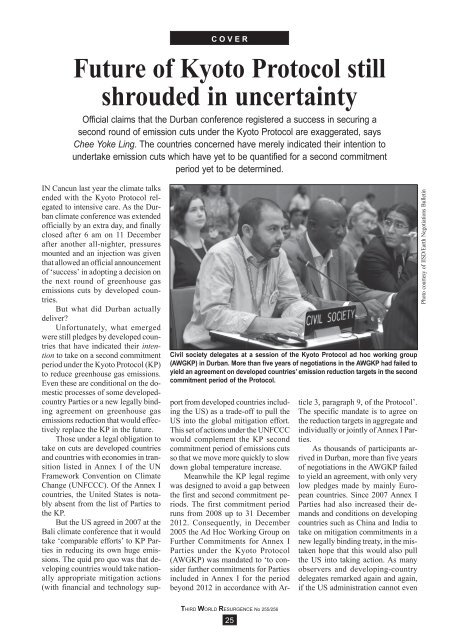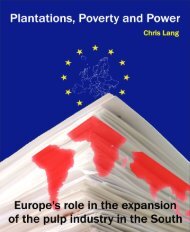C O V E RFuture of Kyoto Protocol stillshrouded in uncertaintyOfficial claims that the Durban conference registered a success in securing asecond round of emission cuts under the Kyoto Protocol are exaggerated, saysChee Yoke Ling. The countries concerned have merely indicated their intention toundertake emission cuts which have yet to be quantified for a second commitmentperiod yet to be determined.Civil society delegates at a session of the Kyoto Protocol ad hoc working group(AWGKP) in Durban. More than five years of negotiations in the AWGKP had failed toyield an agreement on developed countries’ emission reduction targets in the secondcommitment period of the Protocol.IN Cancun last year the climate talksended with the Kyoto Protocol relegatedto intensive care. As the Durbanclimate conference was extendedofficially by an extra day, and finallyclosed after 6 am on 11 Decemberafter another all-nighter, pressuresmounted and an injection was giventhat allowed an official announcementof ‘success’ in adopting a decision onthe next round of greenhouse gasemissions cuts by developed countries.But what did Durban actuallydeliver?Unfortunately, what emergedwere still pledges by developed countriesthat have indicated their intentionto take on a second commitmentperiod under the Kyoto Protocol (KP)to reduce greenhouse gas emissions.Even these are conditional on the domesticprocesses of some developedcountryParties or a new legally bindingagreement on greenhouse gasemissions reduction that would effectivelyreplace the KP in the future.Those under a legal obligation totake on cuts are developed countriesand countries with economies in transitionlisted in Annex I of the UNFramework Convention on ClimateChange (UNFCCC). Of the Annex Icountries, the United States is notablyabsent from the list of Parties tothe KP.But the US agreed in 2007 at theBali climate conference that it wouldtake ‘comparable efforts’ to KP Partiesin reducing its own huge emissions.The quid pro quo was that developingcountries would take nationallyappropriate mitigation actions(with financial and technology supportfrom developed countries includingthe US) as a trade-off to pull theUS into the global mitigation effort.This set of actions under the UNFCCCwould complement the KP secondcommitment period of emissions cutsso that we move more quickly to slowdown global temperature increase.Meanwhile the KP legal regimewas designed to avoid a gap betweenthe first and second commitment periods.The first commitment periodruns from 2008 up to 31 December2012. Consequently, in December2005 the Ad Hoc Working Group onFurther Commitments for Annex IParties under the Kyoto Protocol(AWGKP) was mandated to ‘to considerfurther commitments for Partiesincluded in Annex I for the periodbeyond 2012 in accordance with Article3, paragraph 9, of the Protocol’.The specific mandate is to agree onthe reduction targets in aggregate andindividually or jointly of Annex I Parties.As thousands of participants arrivedin Durban, more than five yearsof negotiations in the AWGKP failedto yield an agreement, with only verylow pledges made by mainly Europeancountries. Since 2007 Annex IParties had also increased their demandsand conditions on developingcountries such as China and India totake on mitigation commitments in anew legally binding treaty, in the mistakenhope that this would also pullthe US into taking action. As manyobservers and developing-countrydelegates remarked again and again,if the US administration cannot evenPhoto courtesy of IISD/Earth Negotiations BulletinTHIRD WORLD RESURGENCE No 255/25625
C O V E Rget a domestic climate law passed inthe US Congress, how can it be partof any new international treaty?However, before Durban, theEuropean Union already made it clearthat it wanted its ‘roadmap’ adoptedin Durban: it would accept a ‘political’second commitment period (nota finalised legal amendment to the KPto be adopted in Durban to incorporatea second commitment period) onthe condition that a new treaty processbe launched. This new treatywould replace the KP.On the other hand, developingcountries were of one voice instrongly insisting that the level ofmitigation ambition in the secondcommitment period must be in accordancewith the requirements of scienceand there must be no gap after2012 (as agreed by all KP Parties).The KP must be kept alive and its implementationstrengthened – the factthat the KP covers only Annex I Partiesis because of their historical responsibilityfor global warming, andequity requires them to take the leadto do more.Besides, since 2010 with theCancun decisions, developing countries(except for least developed countriesand small island states) have alreadycommitted to taking mitigationactions that will be subject to internationaltransparency requirements, beyondtheir UNFCCC obligations.So the pressure was intense inDurban as to who will be responsiblefor ‘killing’ the KP if no second commitmentperiod was accepted.The South African governmentthat hosted the 17th and 7th meetingsof the Conference of the Parties (COP17) to the UNFCCC, and the COPserving as the Meeting of the Partiesto the KP (CMP 7), respectively, wasdetermined to have a success underits watch. Foreign Minister MaiteNkoana-Mashabane, in her capacityas President of the COP 17/CMP 7,was a key player. It was hard over the15 days to not conclude that the EUagenda was at the forefront of thePresidency’s preoccupations.At an informal joint plenary ofthe COP and CMP on the night of 10December, the ‘Durban package’ waspresented to Parties comprising (i) thesecond commitment period for emissionsreductions by Annex I Partiesunder the Kyoto Protocol; (ii) a decisionon the work of the Ad Hoc WorkingGroup on Long-term CooperativeAction under the Convention(AWGLCA); (iii) a decision on theGreen Climate Fund; and (iv) anagreement on the establishment of anew ad hoc working group on theDurban Platform for Enhanced Action(to develop ‘a protocol, another legalinstrument or an agreed outcome withlegal force’). The ‘Durban Platform’document triggered strong statements,disagreements among developed anddeveloping countries, and considerablefrustration and confusion.Nkoana-Mashabane asked Partiesto adopt each of the decisionswithout further debate and amendmentswhen they were presented duringthe formal sessions of the COPand the CMP respectively, saying thatParties required ‘assurances fromeach other to agree to all the draft decisions’,clearly suggesting a ‘take-itor-leave-it’approach.Up until the last hours of the conference,when the AWGKP met afterthe informal joint plenary, there wasstill no consensus on the draft decisionon the second commitment periodprepared by the AWGKP Chair,Adrian Macey of New Zealand. Proposalsby several developing countriesto strengthen the decision werenot accepted, and the only change thatentered the document was from theEU to include an option of an eightyearcommitment period as opposedto five years (this was in the Chair’sdraft and reflects the position of almostall developing countries becauselow pledges over a longer periodmeans even less real emissions reduction).After a heated debate, with severaldeveloping-country Parties expressingfrustration and disappointment,Macey decided to transmit thedraft decision under his own responsibilityfor approval by the CMP 7.As the dust settles in the aftermathof the Durban conference, manydeveloping-country Parties are concernedthat there is still no legallybinding second commitment period asenvisaged under the KP; the ambitionlevel is too low compared to what isrequired by science; there is no aggregatenumber for the overall greenhousegas reduction with each Partyfree to set its own level; and the lengthof the commitment period is uncertain(it can be five or eight years, tobe decided in 2012). Some expert observersare of the view that the essentiallyvoluntary nature of the Durbandecision, with no political support forany more commitment periods, willmark the effective end of the KP.This weak decision was neverthelessadopted in a manner that poses aserious threat to the multilateral, open,inclusive and transparent decisionmakingprocesses that we expect ofthe UN. The South African Presidency,the Chairs of the AWGKP andthe AWGLCA (Daniel Reifsnyder ofthe US) and some who would neverbe officially named wielded considerableinfluence by ultimately shapingdraft decisions that they consideredwere ‘balanced’ and ‘politicallyachievable’. (See the articles ‘Theclash of paradigms in Durban’ and ‘Aflagrant violation of practice and procedure’in this issue.)Debate in AWGKPDuring the AWGKP plenary fromabout 6.30 pm to 8.15 pm, Nicaragua,on behalf of the Bolivarian Allianceof the Peoples of Our America(ALBA), Bolivia and Kenya proposedspecific amendments to strengthen thedraft decision, expressing deep concernsover the weak operative paragraphsthrough the use of terms suchas ‘takes note’ (rather than ‘acknowledges’)and ‘invites’ (rather than‘mandates’).The paragraphs concerned andlater adopted by the CMP 7 withoutany change are as follows:Para 3: ‘Takes note of the proposedamendments to the Kyoto Protocol’developed by the AWGKP containedin the Annexes of the Decision;Para 4: ‘Further takes note of thequantified economy-wide emissionreduction targets to be implementedby Parties included in Annex I as com-THIRD WORLD RESURGENCE No 255/25626















